Hans-Dieter Flick has garnered international acclaim after steering Bayern Munich’s turbulent start to their 2019/20 campaign under Niko Kovac and helping the club to their second-ever continental treble in his first nine months as a manager. He joined the Bavarian giants as Kovac’s right-hand man at the start of the season but took over as manager, due to Bayern’s poor performances under the Croatian, on a temporary basis that became a permanent move after.
Prior to his move to club football, Flick had great success in international football as the assistant to Joachim Löw for the German national team. The pair have worked together since 2006 and have been instrumental in the success of the national team’s success, which peaked when Germany won the World Cup in 2014. Bayern Munich’s tactics and play style share similarities with the football played by Germany in 2014.
This tactical analysis will look at how Hansi Flick’s Bayern team and Jogi Löw’s Germany side operate in each phase of the game, which will determine the influence that the treble-winning manager took from his former boss.
Defensive organisation
First, we will start off with how Germany set up defensively in the World Cup. Of course, each match is different so formations and set-up are tweaked depending on the opposition on both ends of the pitch, not just defensively. However, many of the principles that Germany adopted are used in each formation they played whether that was a 4-3-3 or 4-2-3-1.
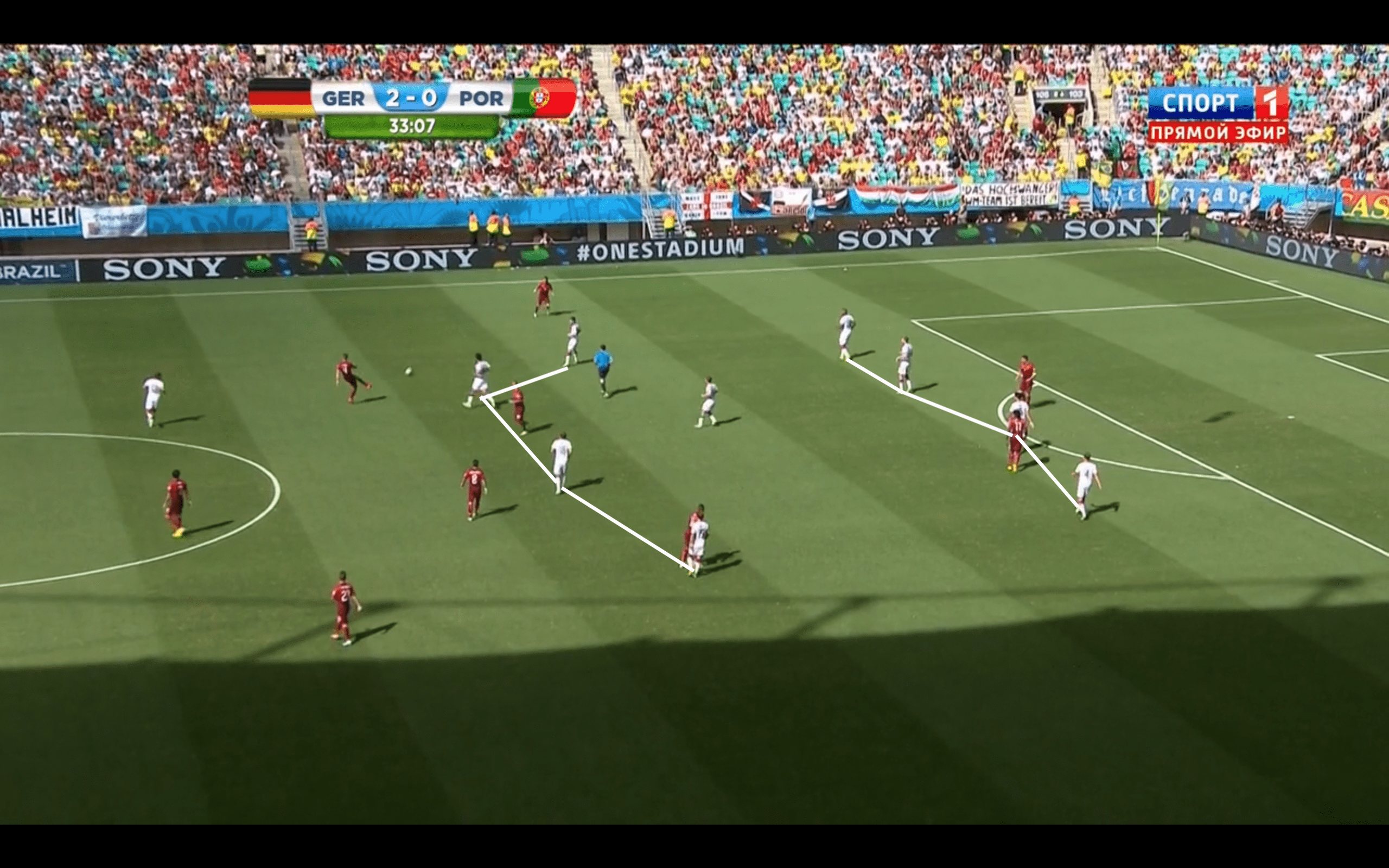
The image above shows how Germany tends to be in a mid-block. They line-up in a 4-1-4-1 with Phillip Lahm usually the lone pivot but as the tournament progressed he went back to his favoured right-back position and Germany switched to a double pivot. The image shows the gaping space next to Lahm on either side but Germany do well to defend the half-spaces. The midfield four are compact enough to prevent vertical passes into the half-spaces and if the ball is played out wide, the German wide midfielders close the opposition down to prevent the ball being played into the half-space. Credit has to go to the likes of Mesut Özil and Mario Götze who often were the wide midfielders despite them playing out of position and often carrying a creative burden. The man to man pressing is a key component for Germany in their defence. If the ball does bypass the midfield into the half-space and there is a player who has dropped in between the lines, the centre backs push up to win the ball back quickly.
Germany were rarely in a deep block in the World Cup as they had the larger share of possession in all their games but for them, the weakness was their transition defending. It was the area that every team that faced Germany had targeted. Germany’s man to man pressing helped them win the ball back more often than not but sometimes their high line was exposed given that they left a lot of space in behind. With Lahm in central midfield, it meant that Boateng had shifted out to right-back meaning the centre-back pairing for die Mannschaft was Per Mertesacker and Mats Hummels – two players renowned for their lack of speed.
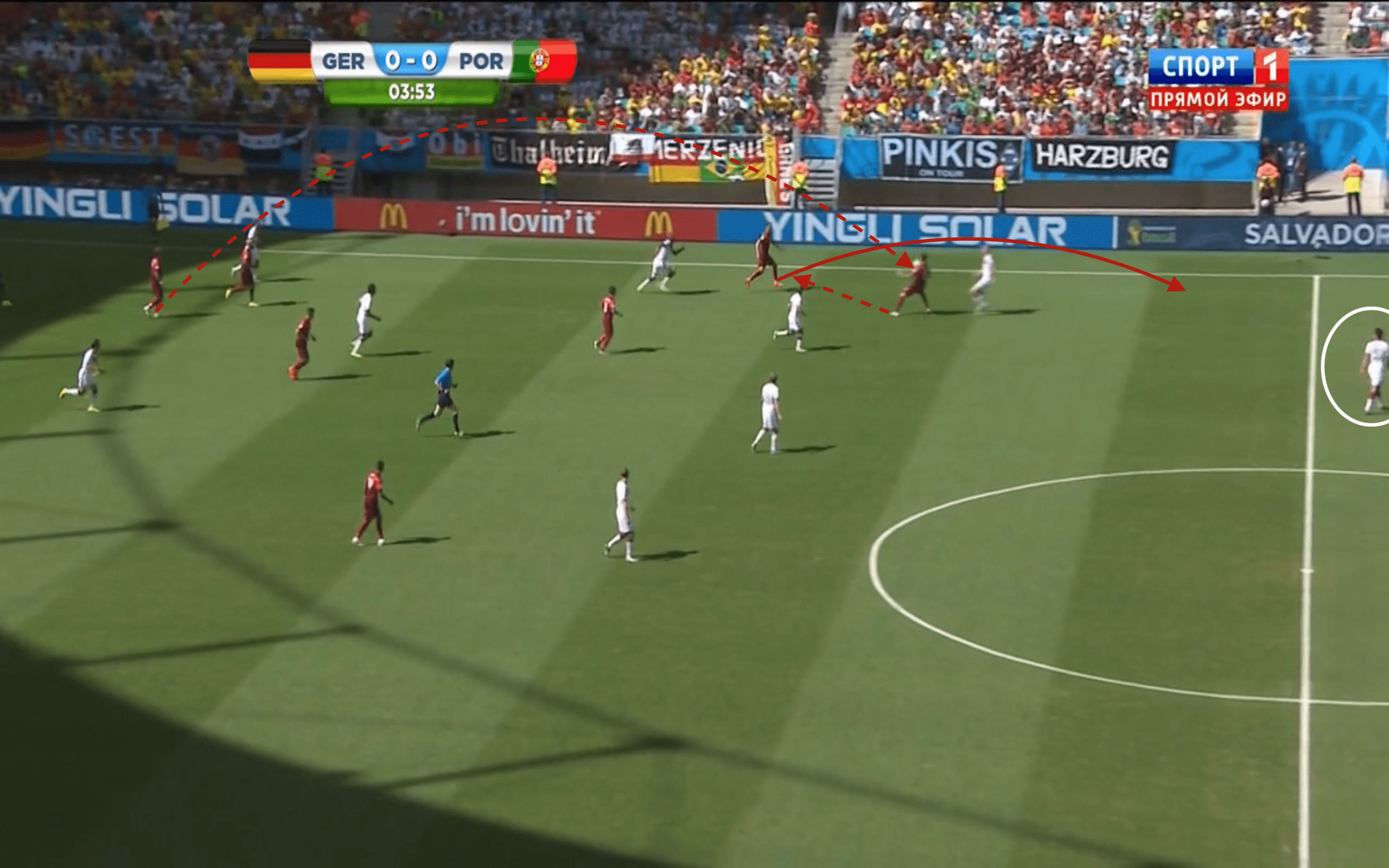
This example is from the same game but occurs just before the fourth minute. We mentioned the centre-backs pushing up to press and win the ball back and this happens here but much higher up the pitch with Mertesacker. Portugal exploited this brilliantly by using a third man supporting run, something more teams should have employed against Germany, with Cristiano Ronaldo as the third man here and Hugo Almeida acting as the target man. As the image shows, only Hummels is left to beat and is only just behind the halfway line essentially giving Ronaldo and Almeida two-thirds of the pitch to take advantage of their 2vs1 situation. Germany’s defenders, especially Lahm and Hummels, do well to track back and force the ball off Ronaldo to Almeida who can only get a tame shot off that lands straight into Manuel Neuer’s hands.
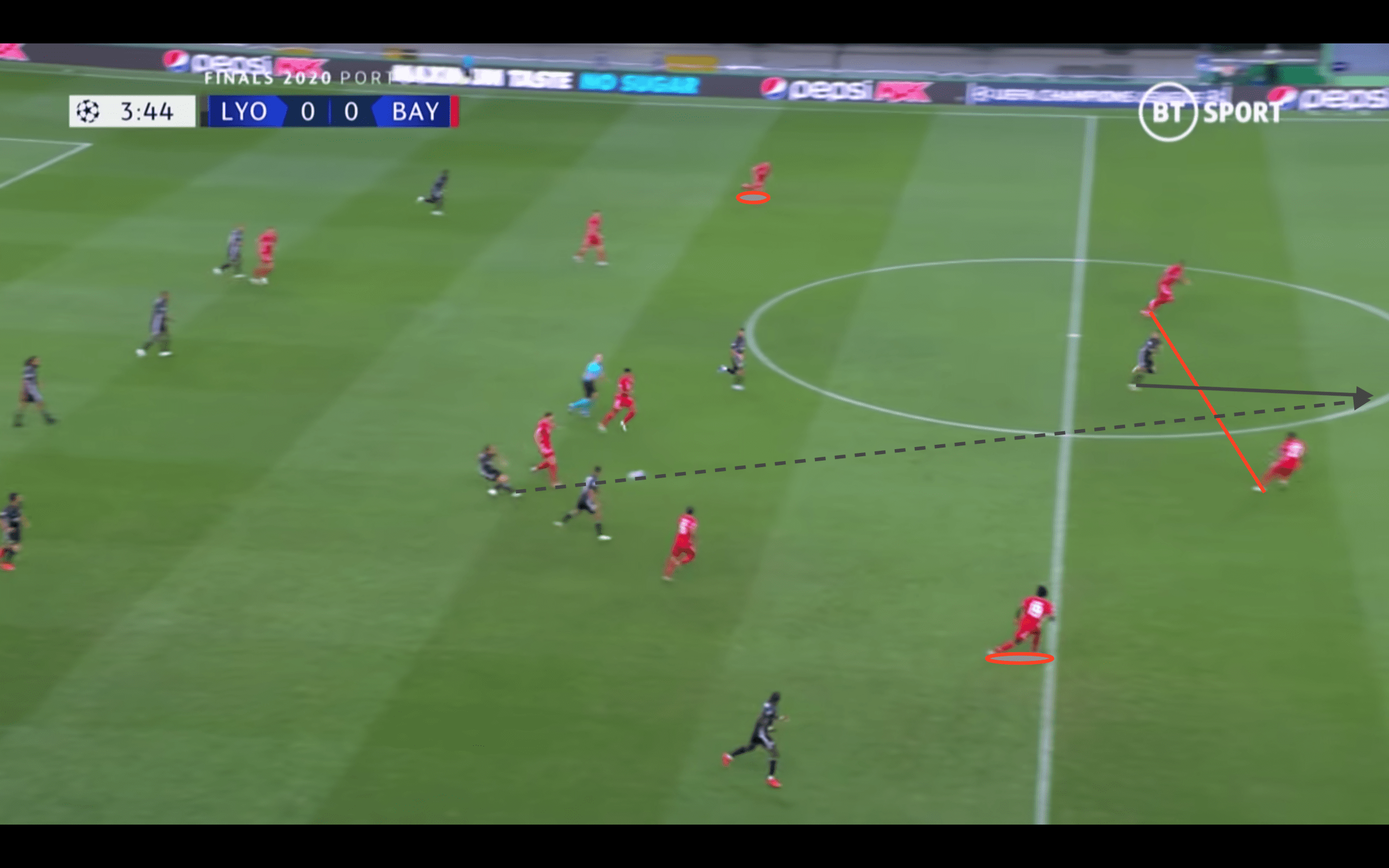
Like Germany, Bayern Munich under Flick have had the same issue especially in the later rounds of the Champions League when the rise in the opposition’s quality is evident. The example above showcases how Olympique Lyonnais exploited the extremely high line that Bayern deployed. Munich’s full-backs are high leaving them with just the two centre-backs defending. David Alaba has transformed into a fantastic centre-back, a position he only played for a little time under Pep Guardiola, but his relative inexperience at this position shows in the contrasting movements between him and his partner Jerome Boateng. Boateng looked to play the offside trap so he was alongside Memphis Depay but Alaba wanted to cover the depth and stop the pass in behind. The confusion accompanied by a brilliant pass by Maxence Caqueret puts Depay through on goal but he misses a gilt-edged chance. While this may seem a huge weakness, there is a method to the madness as Bayern’s system in front of the system means that teams struggle to even get the chance to play the ball in behind the defence. Here, it took a miscommunication at the back and a fantastic final ball to open up Bayern but even if this happens again, Manuel Neuer plays the sweeper role perfectly in goal and can clean up any balls in behind.
The reason as to why the defensive line is so high is that it allows Bayern to have an intense man to man gegenpressing. Under Flick, they have been one of the best gegenpressing sides in the world. This is shown by the fact that they have the second-lowest passes allowed per defensive action (PPDA) in the Bundesliga and win possession of the ball 34.7% of the time via pressing, which is the highest rate across Europe’s top five leagues. One of their best strategies in pressing is when the opposition takes their goal kick.
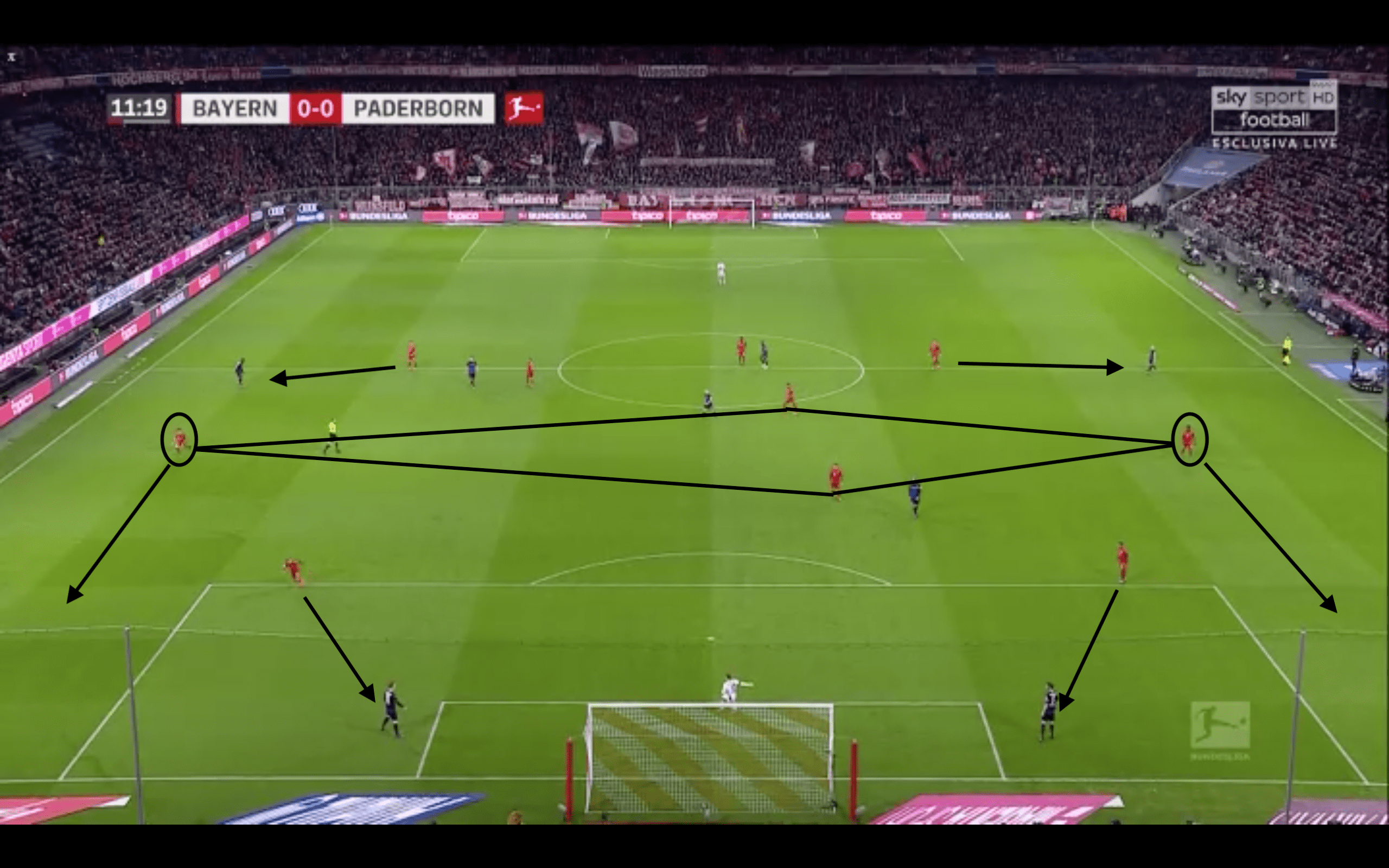
This example against Paderborn encapsulates everything about how Bayern like to press in this scenario. Even though Paderborn lined up with a double pivot, they played out the goal kick with a number six hence Bayern lined up in a diamond in midfield. As per usual, Robert Lewandowski is tasked with marking the number six while the two wingers press the two centre-backs. Bayern’s wing-backs Alphonso Davies and Alvaro Odriozola, circled in the picture, will look to press the opposition’s full-backs and pin them down so that Paderborn aren’t able to launch an attack. However, they aren’t too close to the full-backs for good reason. Since nearly every Paderborn player is marked, Bayern are waiting for the goalkeeper to kick it long or play it to his centre-backs who shift the ball to the full-backs. When the ball is played to the full-backs, this is Bayern’s pressing trigger and either Davies or Odriozola are quick to press and Bayern instil their high gegenpress again to win the ball back. In this instance, Paderborn’s keeper is forced to go long and Bayern win the second ball and recycle possession.
Build-up
While Germany went on to go and win the World Cup, the football they played particularly with the talented technicians at their disposal was somewhat subpar. This could be down to the fact that international football simply doesn’t have the same quality of play as club football given that coaches have less time to coach their players of a certain playstyle. Regardless, Germany’s build-up play was somewhat static as they struggled to break down teams with deep blocks.
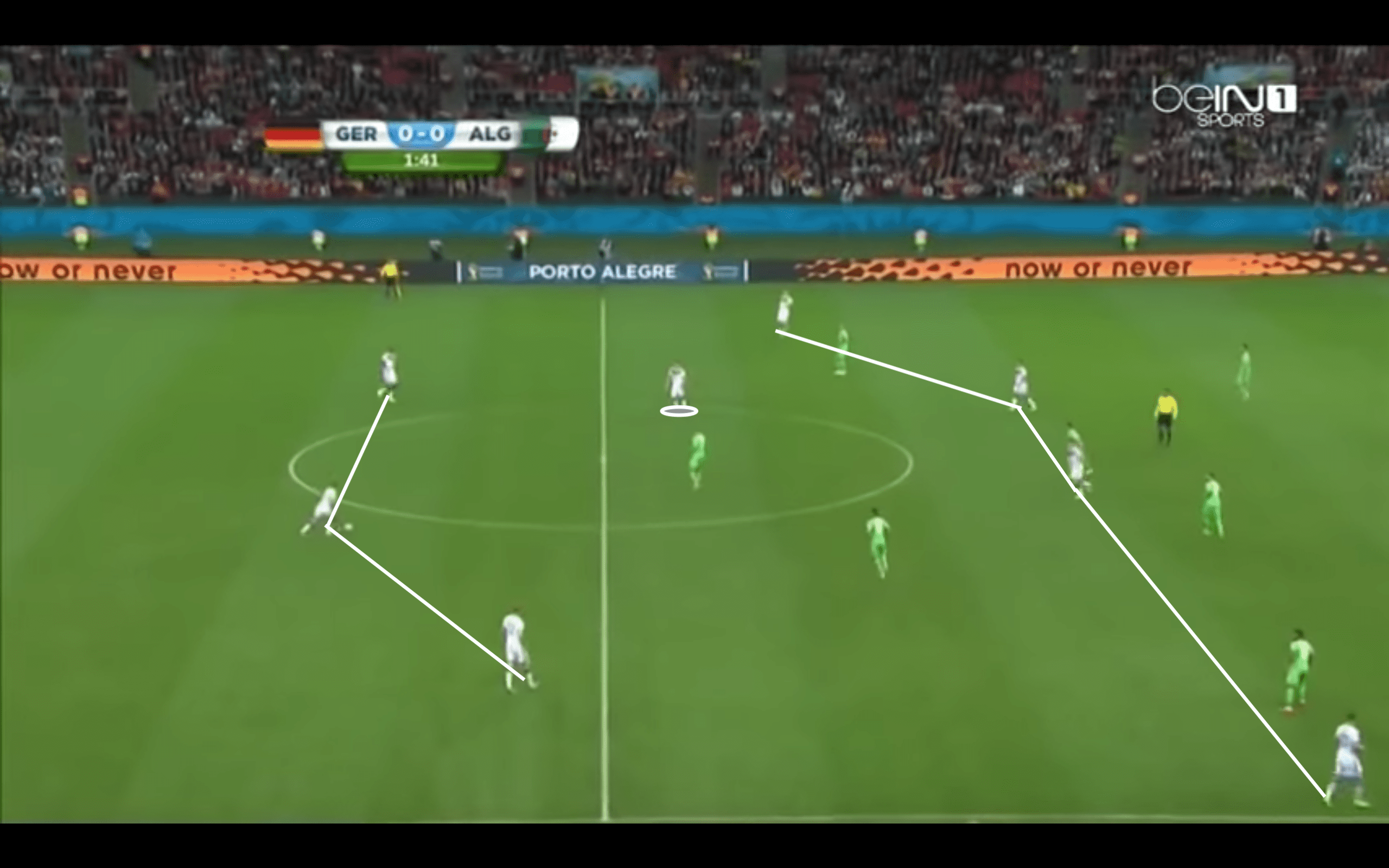
With Lahm often operating as the lone number six, Germany tended to have him drop into the defence and split the centre-backs to create an overload in the first phase. Toni Kroos drops deep into the left half-space whilst the full-backs and the two central midfielders create a four in the middle. Germany try to have a fluid system in that when the build-up down the left fails to materialise, they employ the same 3-1-4 formation but with a player like Özil dropping into the right half-space.
While Germany can easily break the first line of pressure with this structure, the midfield four and front two gave Die Mannschaft a lot of problems. This comes from the personnel but also structurally too. Against Algeria, Löw used Lahm in midfield so the full-backs were Benedict Höwedes and Shkodran Mustafi, both who are centre-backs so they offered limited production offensively. The front two consisted of Thomas Müller and Götze and while the former can be a good forward especially in 2014, the latter couldn’t hold his position as he is a natural playmaker that likes to drop a little deeper.
Of course, there were examples where their structure was better and they were able to build-up the play well. The game against Portugal provided one such example. Germany built play up in a slightly different formation in this example with Lahm staying in his number six role rather than dropping into defence. They lined up in an asymmetrical 2-2-3-3 with the first two being the two centre-backs, the second two being Lahm and a full-back. The first three composed of the two central midfielders and the other full-back who was higher up while the front three stayed high.
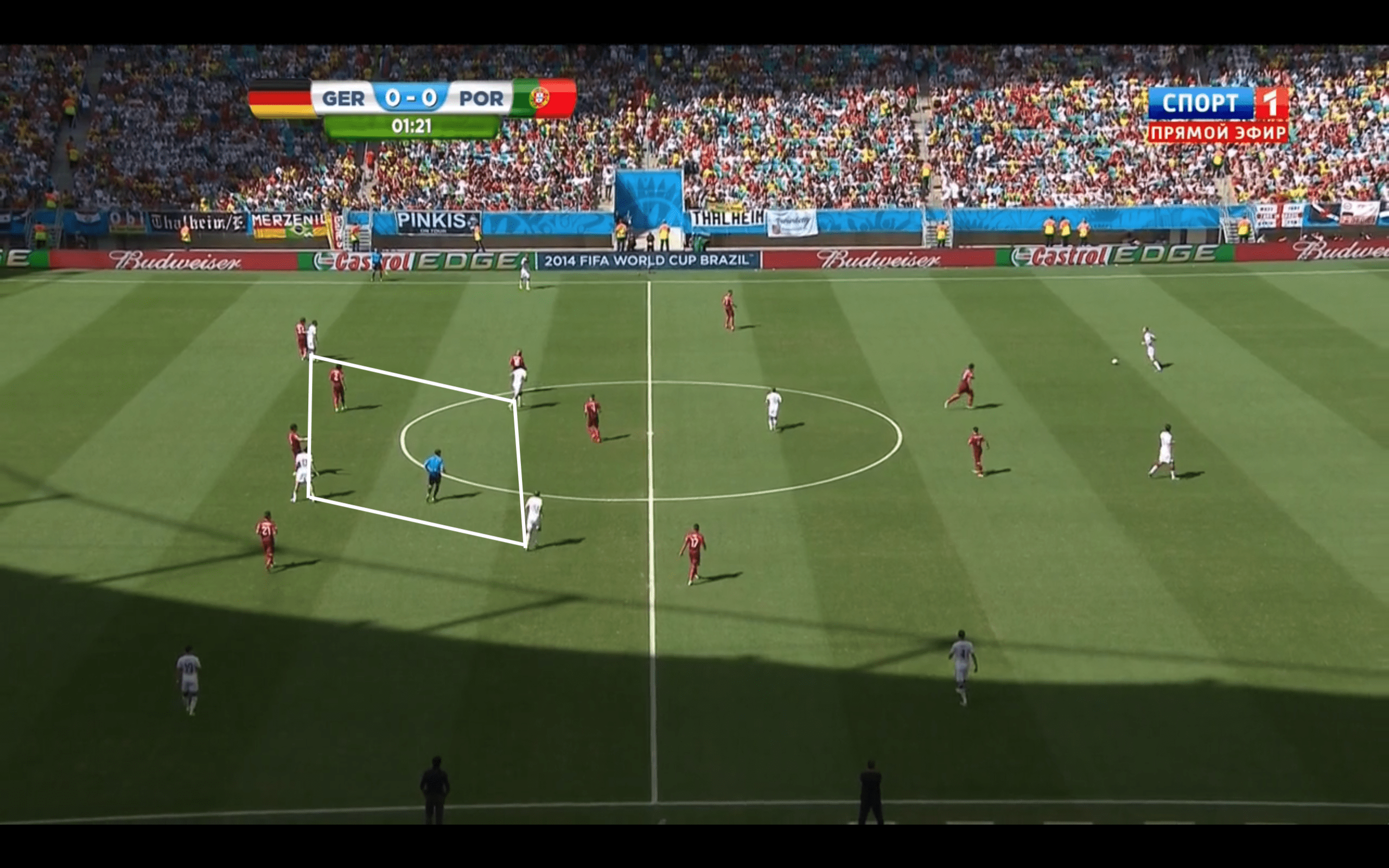
This structure helps create an offensive overload as a box forms and Germany’s build-up becomes much better in the final third. Just a few seconds later, this clear structure allows Germany to create an attacking opportunity.
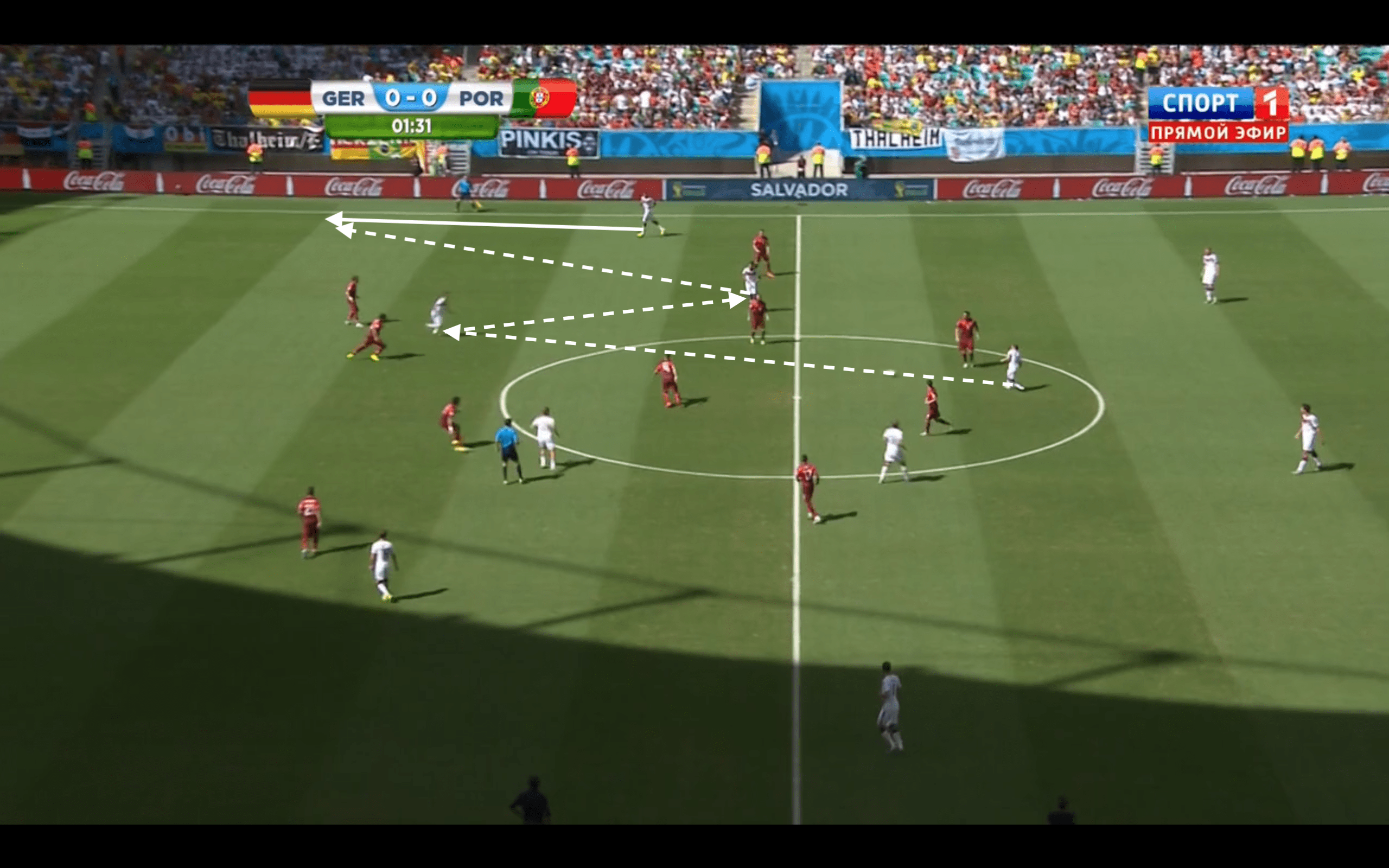
The set-up allows for vertical line-breaking passes to be played as shown above. The full-back is high to provide width while the forward drops in between the lines for a one-touch lay-off. Germany uses the up-down-through passage of play, one that is now a common trend in many teams who are great in possession. It’s a method of ball progression that they did not use frequently enough, which is mostly down to the structural issues they had as a team. The quality in the way Germany lined up here lies in the fact that this can also be done on the other side too.
Hansi Flick seems to have taken some inspiration from how Germany structured their build-up play. Their build-up play is a little bit more fluid than how Germany did it but they also tweaked the formation as they used an asymmetrical 3-1-3-3. The first three consisted of a midfielder from the double pivot splitting the two centre-backs, usually Thiago and the single player would be the other midfielder from the double pivot, usually Joshua Kimmich. The two wingers would drop in between the lines and more centrally with the near side full-back alongside the horizontal plane. The front three would be made up of the far side full-back and the two forwards, usually Lewandowski and Müller, who create a box-like Germany did with the two wingers who come inwards.
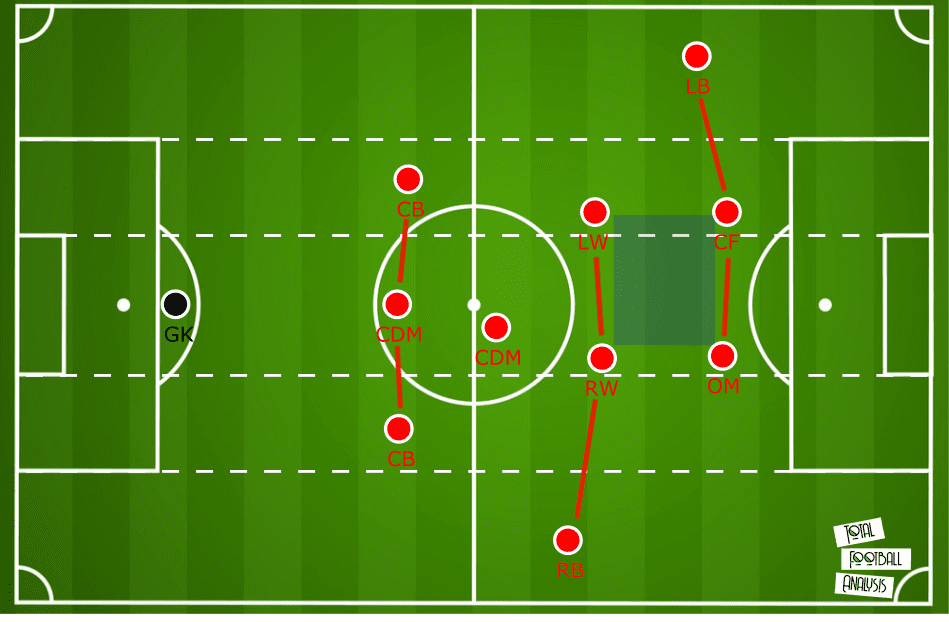
This structure of play is fantastic for Bayern as it allows to create positional overloads in nearly every phase of play. In the first phase, their back five consisting of the near side full-back, the sole number eight and their back three is great as they are able to outnumber most pressing sides, especially in the Bundesliga given that most teams employ a press, by drawing the opposition in before finding one of their wingers in between the lines. Once the wingers receive the ball, they can either connect with the two forwards or play the pass wide to the far side full-back who can cross the ball in. This system works fantastically well given the personnel at the club. Bayern are stacked with players who can perform multiple roles and play different positions so it allows the team to be even more fluid and gives them the ability of positional rotation. The likes of Alaba, Thiago and Kimmich are crucial to this system as they provide the best ball progression for the team, as shown by the fact that they are the top three players in that statistic at the club, given their technical ability on the ball.
Attacking play
Since Germany struggled in the build-up department in the World Cup, their attack was a little feeble too. They only managed more than three goals in two games, the opening against Portugal thanks to a penalty, set-piece and a red card for Portugal as well as the iconic 7-1 drubbing to home nation Brazil, which was partly down to a capitulation from the Brazil team.
However, there were two clear routes in which Germany scored throughout the tournament. The first one being set-piece, with Die Mannschaft scoring five goals from either a ball in from a corner or a free-kick as they utilised the great deliveries of Toni Kroos and the aerial threat of Mats Hummels. The second route was via crosses whether they were from deep or were cut-backs across goal. This is shown by the fact that 7 of their 12 goals come from a variation of a cross.
This is perhaps the area that Bayern takes the biggest inspiration from the Germany side and this is shown by the fact only Eintracht Frankfurt had more crosses from open play in the 2019/20 season. Both Bayern and Germany have a near-identical structure when crossing as they both line up in a 1-4 formation.
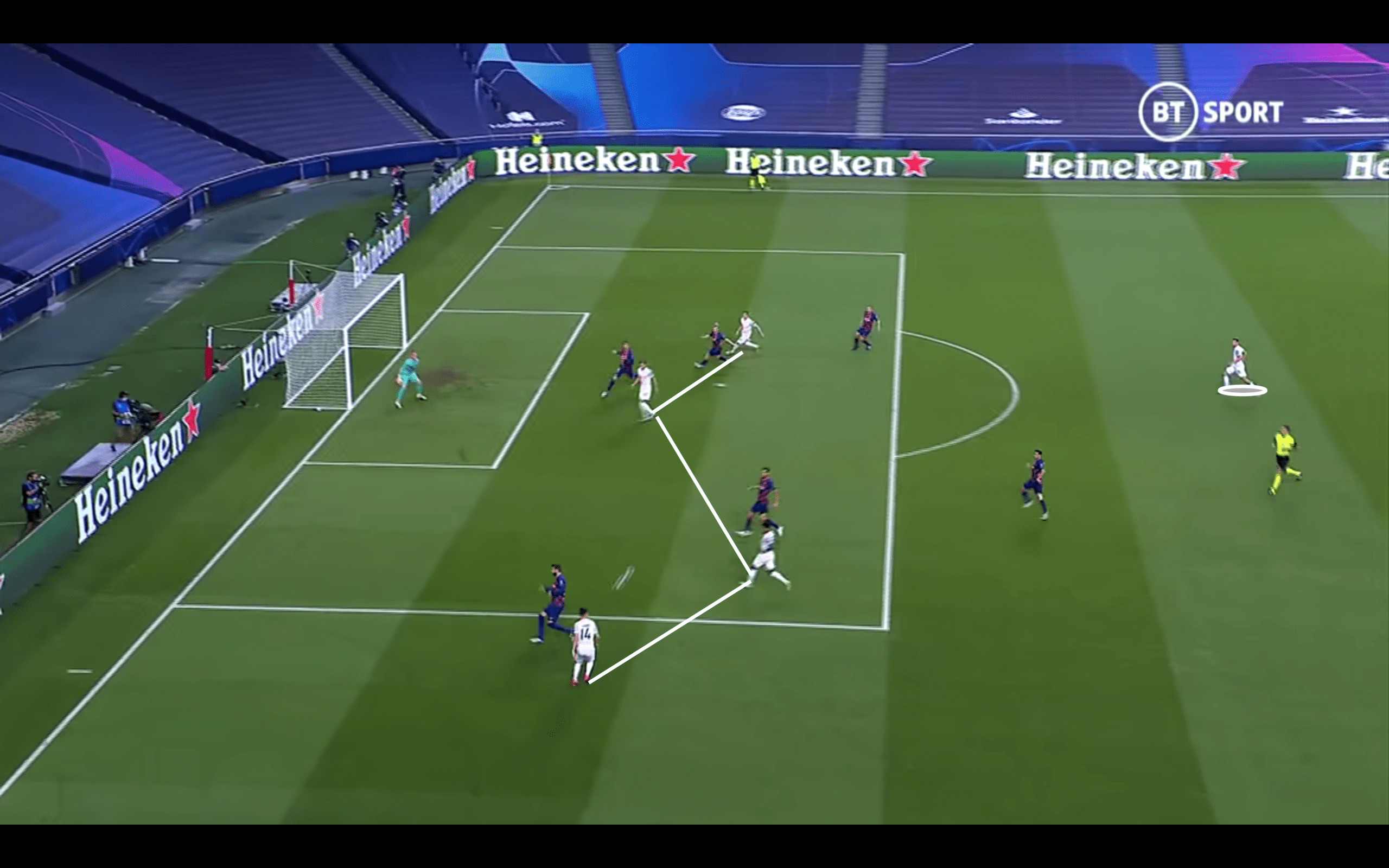
The example above is from Bayern’s 8-2 thrashing of Barcelona in the Champions League and clearly highlights Die Roten’s structure for their opening goal. Müller operates as the one in the 1-4 formation in this scenario whilst Perisic is wide looking to put the ball into him or Gnabry, Goretzka and Lewandowski who are in the box. The role of the one is to arrive late into the box or stay on the edge as an additional option as Müller is here, whilst the three attackers are looking to find space in the box for what is usually a cut-back. In the end, Perisic crosses it into Müller who combines with Lewandowski for a well-worked Bayern goal. The beauty of how Bayern use this is in their versatility. The late runner in the box can be either the number 10, striker, winger or box to box midfielder and in rare instances can even be a full-back. Their attacking fluidity and the players’ ability to play in different positions and roles gives them great success in executing this final third play.
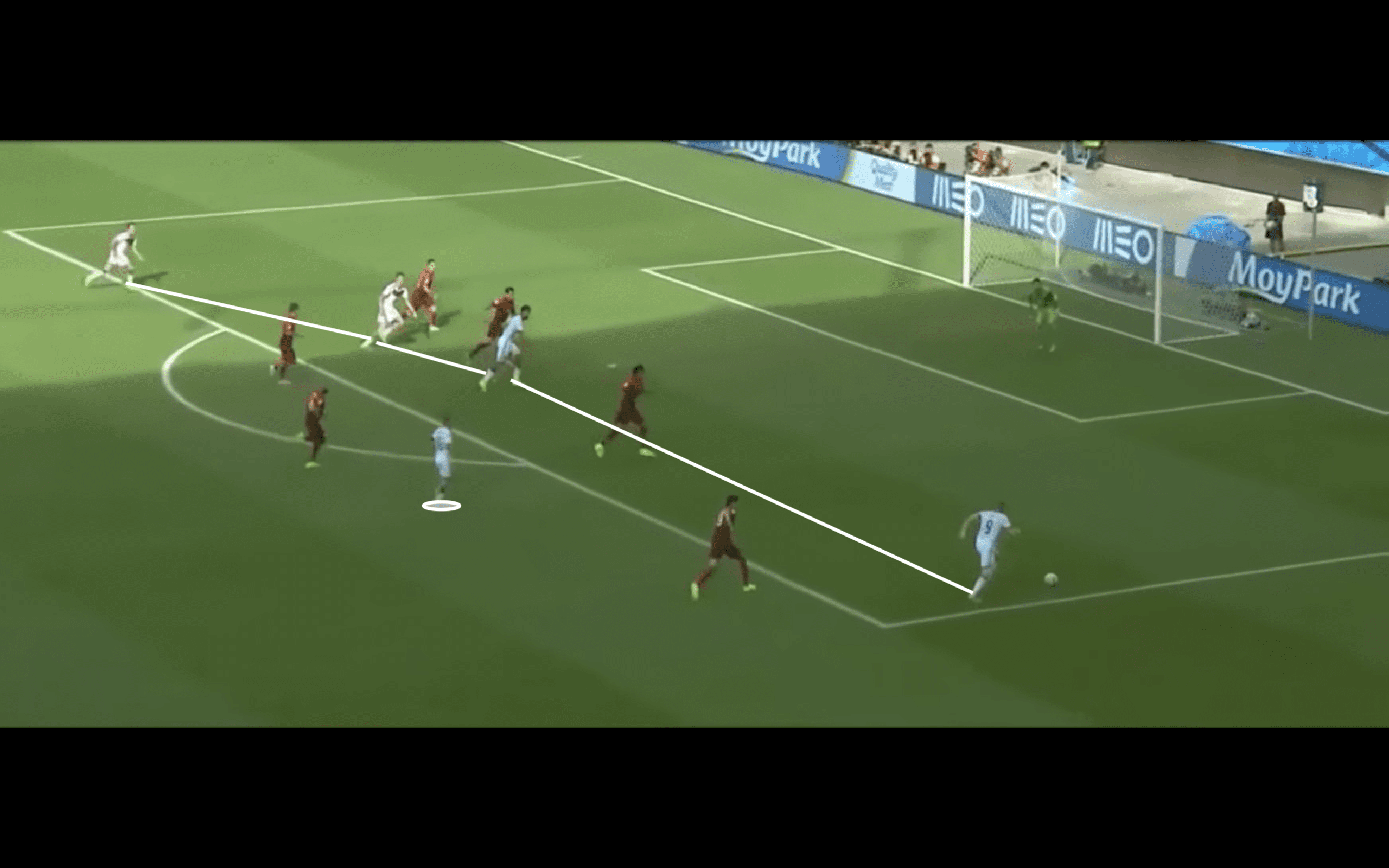
As shown above, Germany had the same structure too with Lahm acting as the late runner into the box. Andre Schürrle was out wide looking to play the ball into either Lahm or one of the three attackers who in this case were Müller, Götze and Sami Khedira. This example against Portugal also led to a goal after Schürrle’s cross was fumbled into the path of Müller who was able to tap in easily. Germany lacked the fluidity and versatility that Bayern possessed but were versatile enough to perform this action very well thus helping them score a lot of goals. There were some issues though with this play as sometimes they overloaded the box and could often find themselves having six or seven players around the area, which became an issue as it meant their defence were exposed in transition. Regardless, they were able to cope just fine and the success they found in the World Cup using the 1-4 formation when crossing helped lay the blueprint for Flick and Bayern’s success in the 2019/20 season.
Final remarks
This analysis should showcase that Flick did indeed grab a lot of inspiration from Germany’s tactics at the 2014 World Cup, which should come as little surprise given his involvement in the tactics as well as the success Germany encountered. Upon review, Germany’s football was not played as well as initially thought given that they won the World Cup but the tactical blueprint set out by Löw and his staff for success was definitely clear to see. Flick built on this and made improvements to the system and that has helped Bayern see success in his first-ever managerial jobs and has made the club become one of the world’s most feared teams who could dominate football for the next few years.

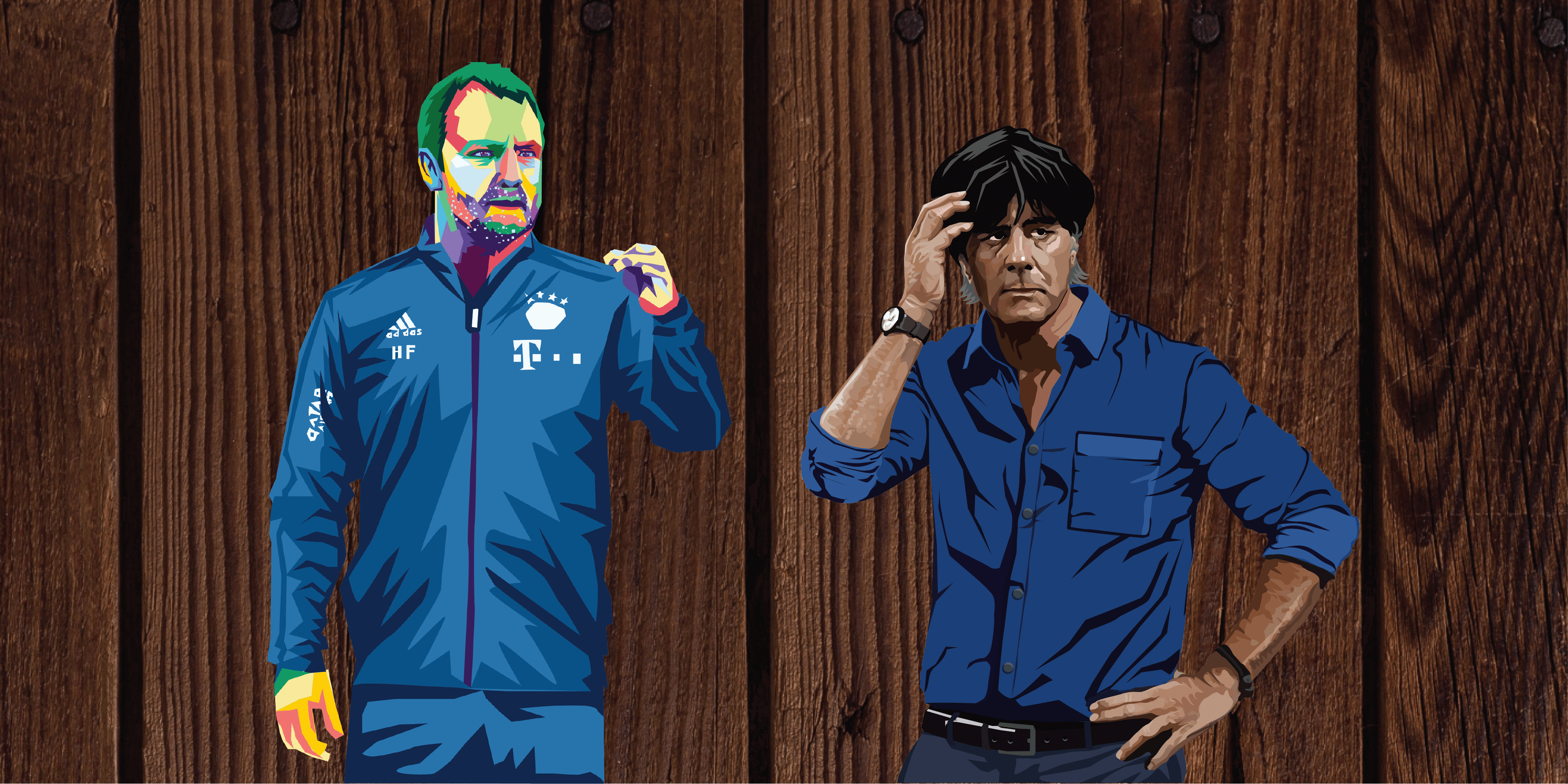



Comments